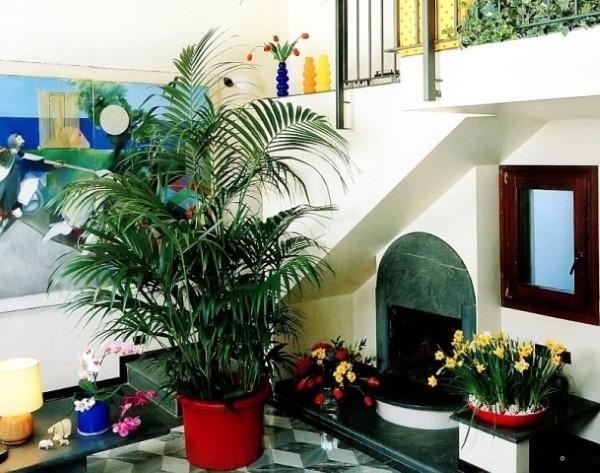The unpretentious hovea pinnate palm for your home
 The Hovea palm tree is simply created for those flower growers who dream of such a plant, but are afraid of possible difficulties in caring for it. Of all the varieties of palm trees, this is perhaps the most capricious flower. In addition, it is also very decorative thanks to its interesting leaf shape.
The Hovea palm tree is simply created for those flower growers who dream of such a plant, but are afraid of possible difficulties in caring for it. Of all the varieties of palm trees, this is perhaps the most capricious flower. In addition, it is also very decorative thanks to its interesting leaf shape.
Today we'll talk about what Hovea is and how to grow it at home. The Hovey palm is also called Kentia. Read about date palm!
View characteristic
Growing in natural conditions, Hovea has a pretty impressive size. Arcuate long leaves lean to the ground, while the length of only the petiole itself reaches 2 m.At the end of such petioles are the leaves themselves in the form of a fan. Of course, like a tub plant indoors, its dimensions are much smaller.
As already clear, the trunk palm does not, but this does not prevent her from remaining one of the most beautiful plants. Long petioles form a kind of bush, while Hovea reproduces by lateral shoots.
If for some reason a part of the plant disappears, it does not die at all - you can always get new plants from the lateral petioles.
Care features
Growing Hovea is not difficult at all. When comfortable conditions are created, the flower grows into a beautiful lush bush with chic feathery leaves. These include:
- Good lighting... In winter, the tub must be placed at the southern window, otherwise the flower will begin to stretch and turn pale. But in the summer, on the contrary - the palm tree standing under the window should be shaded with a tulle curtain. By the way, in the thick shade, Hovea will not disappear, but it will not gain that powerful beauty that is characteristic of the species.
- Fresh air... Since the palm is an outdoor plant, it needs fresh air. To do this, you should often ventilate the room where the flower grows, from early spring to late autumn.
- Correct pot... The root system of a palm tree has the shape of an elongated rod, so the tub for it must be deep. At the same time, the width of the flowerpot should be sufficient for the development of young growth.
- Sufficiently heavy soil... The Kentia palm does not like loose and light soil and grows best in a soil mixture in which sod land is present. Ready-made substrate for palm trees can be bought in a store or made by yourself by mixing 4 parts of sod land, 2 parts each of leafy soil and humus and 1 part of sand.
- Regular feeding... Unlike most indoor plants, which are not fertilized in winter, it is recommended to feed the palm tree in winter. A single application of mineral preparations every month is enough. With the arrival of spring, the frequency of fertilizing increases.